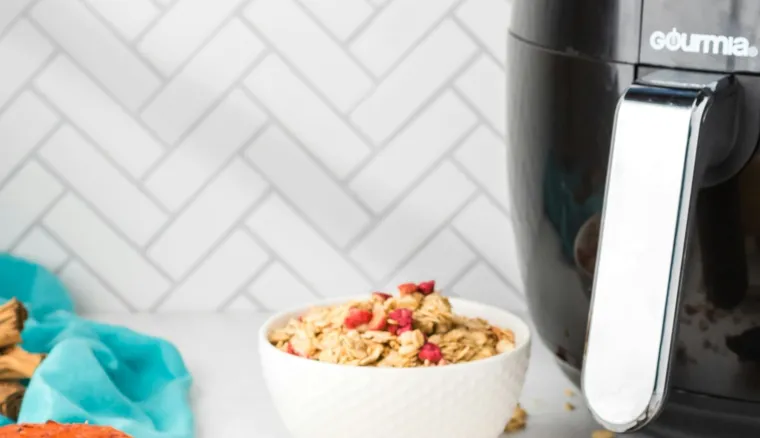Nutrition and food technology experts note that air fryers can reduce fat intake by up to 70–80% compared to traditional frying.In 2025, air fryers continue to evolve, offering more versatility, safety, and convenience for home kitchens.
What Foods Can Be Cooked in an Air Fryer?
Air fryers go far beyond French fries. Popular options include:
- Vegetables (broccoli, zucchini, Brussels sprouts)
- Chicken wings, nuggets, and tenders
- Fish fillets and shrimp
- Baked goods like muffins and cookies
- Reheating leftovers with a crisp finish
Their versatility makes them suitable for snacks, full meals, and even desserts.
Best Air Fryers in 2025: What to Look For
When choosing an air fryer, key considerations include:
- Size & Capacity: Small air fryers (2–4 quarts) for individuals, larger ones (6–10 quarts) for families.
- Non-Toxic Materials: BPA-free, PFAS-free, and ceramic-coated models are popular for health-conscious buyers.
- Crisping Technology: Newer air fryers feature dual heating elements for even crisping.
- Ease of Cleaning: Removable, dishwasher-safe baskets save time.
Types of Air Fryers in 2025
1. Basket-Style Air Fryers – The most common design, featuring a pull-out basket that circulates hot air around food for crisping. Great for fries, wings, and quick snacks.
2. Oven-Style Air Fryers – Larger models shaped like countertop ovens, often with multiple racks for baking, roasting, and dehydrating. Ideal for families or batch cooking.
3. Toaster Oven Air Fryers – Combine the functions of a toaster oven with air frying, saving counter space while offering versatility.
4. Paddle Air Fryers – Stir food automatically during cooking, ensuring even crispiness without shaking or turning manually.
5. Dual-Basket Air Fryers – Allow two different foods to be cooked at once with separate timers and temperature controls.
6. Commercial Air Fryers – Heavy-duty machines designed for restaurants, cafeterias, or catering services that require larger capacity and durability.
7. Smart Air Fryers – Wi-Fi–enabled units controlled by apps or voice assistants, with preset recipes and energy-saving features.
How Much Does a Small Air Fryer Cost?
- Small models (2–4 quarts): Typically range from $50–$120.
- Mid-range models (5–7 quarts): Usually $120–$200.
- Premium or smart air fryers (8+ quarts): Can cost $200–$400+.
Commercial-grade air fryers are significantly more expensive, often exceeding $1,000.
Things You Didn’t Know About Air Fryers
Air fryers don’t actually “fry” food the traditional way—they use rapid hot air circulation to create a crispy texture with little to no oil. Many models can also bake, roast, grill, and even dehydrate, making them more versatile than most people realize. In 2025, some advanced air fryers even include dual-zone cooking, allowing you to prepare two different dishes at once.
BeneFits & Key Facts
- Fat / Calorie Reduction
Multiple sources agree that air fryers can reduce the amount of oil used, and thus the fat content, by 50-80% (often 70-80%) compared to traditional deep frying. - Health Benefits Beyond Fat Reduction
- Less oil means fewer calories, potentially aiding weight management and cardiovascular health.
- Using less heated oil avoids formation of some harmful compounds (e.g. from overheating oils or reusing them) compared to deep frying.
- Non-Toxic Materials & Safety Concerns
- There is growing awareness of nonstick coatings (PFAS, PTFE, PFOA) and their potential health risks. Many modern air fryers are being made with safer materials like ceramic, glass, or stainless steel.
- Guides in 2025 emphasize looking for PFAS-free coatings, non-toxic baskets, and preferring materials like ceramic/glass when possible.
- Size, Capacity & Features Trends
- Compact models (2-4 quarts) remain popular for individuals and smaller households. Larger or dual-basket models are trending for families or for more versatile cooking (roasting, baking, dehydrating) in the same appliance.
- Ease of cleaning, adjustable cooking presets, dual heating / crisping capabilities, and smart features (app/voice control) are increasingly expected in higher-end models.
Conclusion
Air fryers remain one of the most practical kitchen appliances for 2025, combining convenience, healthier cooking, and versatility. From small budget-friendly models to advanced non-toxic or commercial-grade units, there’s an option for nearly every household. By considering size, material, features, and price, buyers can find the best air fryer that suits their cooking habits and lifestyle.
References
- EatingWell. “Is Air Frying Healthy? What a Dietitian Says.” EatingWell
- AirFryerHub. “Comparing Fat Content: Air Frying vs. Deep Frying.” airfryerhub.com
- Homes & Gardens. “Best Non-Toxic Air Fryers 2025.” Homes and Gardens
- TechRadar. “The Best Small Air Fryers 2025: Compact Fryers Tested and Rated.” TechRadar

